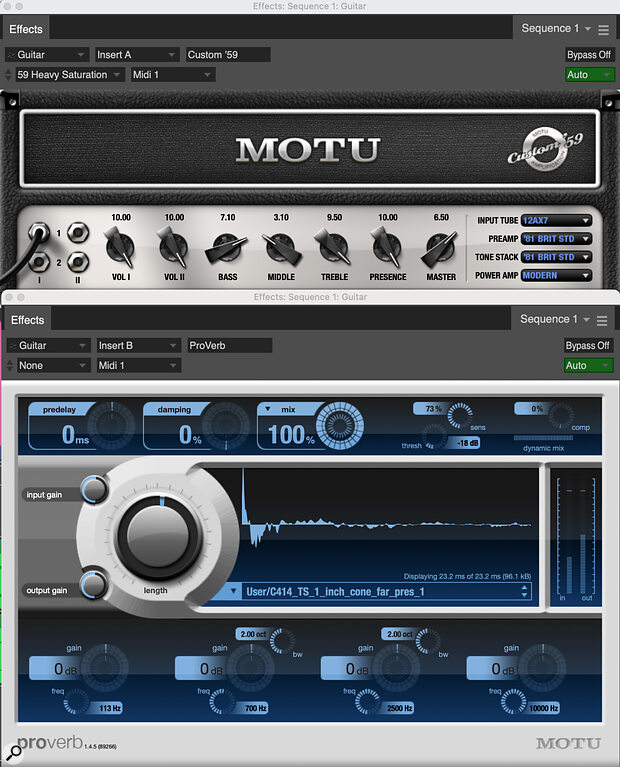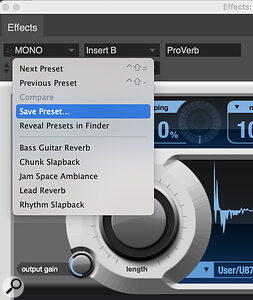 You can use ProVerb as a cabinet simulator by loading speaker‑cabinet impulse responses.
You can use ProVerb as a cabinet simulator by loading speaker‑cabinet impulse responses.
Digital Performer's ProVerb offers an easy way to experiment with guitar amp impulse responses.
Digital Performer’s amp and cab simulations are excellent, but so is the ProVerb convolution reverb — and can use it to expand the number of cabs available to the amps. ProVerb uses convolution technology, where an audio ‘snapshot’ (called an impulse response, or IR) of an acoustic space is used to impart that space’s characteristics to the audio. As an analogy, think of the impulse response as a ‘mould’ of a particular space; you can ‘pour’ your sound into the mould. If the space is a concert hall, the sound takes on the hall’s sonic characteristics. If the space is a cabinet, the sound takes on the cab’s tonal qualities.
There’s a thriving market of third‑party impulse responses, which you can load into guitar amps, convolution engines, effects and amp simulators. You don’t need to spend any money to experiment with cab IRs, because there are plenty of free ones available online. Some of the best include offerings from Wilkinson Audio (wilkinsonaudio.com/collections/free), Overdriven (Overdriven.fr), Kalthallen Cabs (cabs.kalthallen.de) and Sound Woofer (soundwoofer.com). The free IRs from those four sites will give you plenty to start with, and with minimal searching you can unearth even more sources. (You can also find additional reverb IRs that you can use in ProVerb in a traditional reverb scenario to supplement the included collection.)
You don’t need to spend any money to experiment with cab IRs, because there are plenty of free ones available online.
All Formats Great And Small
Once you’ve downloaded some IRs, getting started is easy. Open DP and insert one of DP’s amps, without a Live Room, on a guitar track. Next, follow it with an instance of ProVerb, into which you’ll load your cabinet IR.
ProVerb accepts many audio file types, including WAV, AIFF, MP3 and even MOV. That said, most of the IRs you’ll find will be AIFF or WAV. Some IR collections offer versions at several sampling rates, but it doesn’t seem to matter with ProVerb, which converts the IR so that it works at the session’s sampling rate.
There’s also the issue of mono and stereo IRs. Although more of the available free IRs are mono, some were captured in stereo and sound quite a bit fuller. It’s worth checking out both types. That said, you don’t always want a big, wide stereo image on a guitar track, particularly if you’re going to pan it significantly to one side. Often, a mono track will sit better in a mix.
To keep it simple, you can just match the format of the track and the plug‑ins with the IR. In other words, load a mono IR into a mono instance of ProVerb. If you try to load a stereo IR in a mono version of ProVerb, it will be effectively converted to mono because only one side will load. If you have a mono track and want a stereo cab, you can open a mono‑to‑stereo version of ProVerb and then load a stereo IR.
 You can choose to save your IR to the User, Shared or Project folders.Loading an IR in ProVerb is as easy as dragging and dropping the IR file from the directory where you’ve stored it into the waveform display area in the centre of the plug‑in. You’ll get a dialogue box that allows you to select the save location for the IR. You can choose from several options for where to save it. If you choose Project, it will get saved with your project. If you select User, it will go to the User folder and be available in all your projects. If you choose Shared, it will be available for any logged‑in user of the computer. (For example, on a studio computer where several people have log‑ins.)
You can choose to save your IR to the User, Shared or Project folders.Loading an IR in ProVerb is as easy as dragging and dropping the IR file from the directory where you’ve stored it into the waveform display area in the centre of the plug‑in. You’ll get a dialogue box that allows you to select the save location for the IR. You can choose from several options for where to save it. If you choose Project, it will get saved with your project. If you select User, it will go to the User folder and be available in all your projects. If you choose Shared, it will be available for any logged‑in user of the computer. (For example, on a studio computer where several people have log‑ins.)
If you’re trying out a lot of IRs to find ones you like, you can end up with a pretty long list of them in your User folder, making it harder to find the ones you want. It’s great to have options, but you don’t want to be drawn into option overload. Treat DP’s User folder for impulse responses like a favourites folder, not just ‘a place to store a bunch of impulses’. If it’s not love at first sight with a cab impulse, it probably won’t be love at second sight, either.
If you get to the point where you need to clean out your User, Shared or Project folders, you must do so from your desktop, not from within DP. The IRs get stored in Library folders on the Mac and in Data folders on Windows. DP’s Plug‑ins Guide offers specific instructions for deleting individual IRs or entire folders. It’s worth reading those sections, so you know how to do it.
Taking Control
You don’t have to make many parameter adjustments to use cabinet IRs with ProVerb, but one thing to make sure of is to set the Mix control to 100 percent. You don’t want to mix in the pre‑cabinet amp sound; you want the entire signal to get processed by the cabinet IR.
Depending on the sound of the IR, you may want to experiment with some of ProVerb’s other adjustable parameters. The Length knob can change the perceived mic distance. With many IRs, you get better results by lengthening than by shortening, which can sometimes make the signal sound thin and phasey.
The Length, Damping and Mix controls all require massive calculations by ProVerb’s convolution engine. If you adjust any of them in real time, you’ll often hear a brief glitch as the plug‑in calculates its new setting. (The same is true for Predelay, but you wouldn’t want to use that with a cabinet IR.) As a result, you can’t automate those parameters. However, the EQ, input and output levels, and Dynamic Mixing controls are automatable. ProVerb’s four‑band EQ is particularly helpful for cutting out some lows, below about 100Hz, thus reducing low‑end clutter.
The Dynamic Mixing section consists of Threshold, Sensitivity and Compression knobs. The compressor is located after the signal is processed by the IR and uses the dry signal as its side‑chain input. According to the DP Plug‑ins manual, this “allows a ‘wetter’ mix while retaining intelligibility of the input signal”. Like the EQ, it’s worth experimenting with. If you’d prefer, you can load separate EQ and compressor plug‑ins after ProVerb in the signal chain. DP offers plenty of options for those types of processors.
 The input and output gain controls, and their corresponding meters.
The input and output gain controls, and their corresponding meters.
ProVerb’s input and output gain knobs are handy for eliminating clipping. If you see clipping in ProVerb’s meter, you can use those knobs to get your levels under control.
 Creating a ‘default’ preset is handy for quickly resetting the parameter controls.One thing to remember is that loading a new impulse response doesn’t affect the rest of the parameters in ProVerb, but loading a preset does. Therefore, it’s helpful to create a generic preset with all parameters at their default positions. That way, if you’ve made a lot of parameter adjustments on one IR but want to try a different cabinet sound, you can load your default program to restore the default settings before trying the next one.
Creating a ‘default’ preset is handy for quickly resetting the parameter controls.One thing to remember is that loading a new impulse response doesn’t affect the rest of the parameters in ProVerb, but loading a preset does. Therefore, it’s helpful to create a generic preset with all parameters at their default positions. That way, if you’ve made a lot of parameter adjustments on one IR but want to try a different cabinet sound, you can load your default program to restore the default settings before trying the next one.
Conjugate The Verb
An IR is a snapshot of sound from a moment in time. As a result, a convolution processor is not the right tool for creating effects that change over time, such as modulation and delay. For effects like that, use the insert slots in your guitar channel after ProVerb. DP offers an excellent collection of plug‑ins such as Diamond Drive, Delta Fuzz, Analog Chorus and Analog Delay, to name just some. If you want to go beyond the realm of guitar stompbox effects, DP also offers plug‑ins like Sonic Modulator, Megasynth and Micro G.
Just because you’re using one instance of ProVerb for cabinet emulations, it doesn’t mean you couldn’t put another one later in the signal chain or on an aux track to use as a reverb. A useful effect is to open a preset for one of ProVerb’s smaller spaces (for example, Factory/Delay/Closet, Factory/Plates Guitar or Factory/Rooms/Small), dialled in lightly, to enhance the roominess of the cabinet sounds.
Another handy effect with ProVerb on an aux is to use one of the Factory reverb IRs that offer Left, Right, and Center settings to put some reverb on the opposite side of your panned guitar. Adding a modest amount can make your guitar sound quite full but still seem panned to one side.
 Try using ProVerb as an aux reverb loaded with one of the presets that emphasises the opposite side from where the guitar is panned.
Try using ProVerb as an aux reverb loaded with one of the presets that emphasises the opposite side from where the guitar is panned.
Although DP’s Live Room plug‑ins have lots of great cabinet sounds, you can get additional options with third‑party IRs and ProVerb. Getting into the world of online cabinet IRs is fun, easy and you don’t have to spend a penny. If you use DP for guitar recording, it’s worth your time to give it a try.







